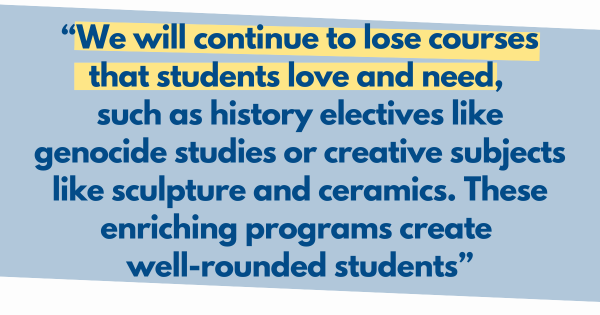
At a special meeting held remotely on June 17, 2024, Councilor Rothenberg presented a budget map for school funding to City Council members, Mayor Sciarra, and City Finance Director Nardi. Councilor Rothenberg invited two NPS teachers to present statements at the meeting. Kate Fontaine, high school teacher, read the following statement.
I am here to speak about the financial repercussions of these cuts for our district. The reality is this: we have insufficient funding for our schools. Not only, as Dr. Morgan has eloquently laid out, are there significant impacts on the quality of the education we’re able to provide, but this is going to end up costing the district more money over time.
As we remove services and service providers who provide interventions at stages one, two, and three, more students are going to fall behind. When students fall behind, they end up qualifying for special education services. This means we’ll have more students on individualized education plans (IEPs), which are legally binding and costly. The more students we have on IEPs, the more special education staff we will need. Typically, when we add special education staff, we end up reducing the amount of general education staff we have, leading to a loss of programming.
At the elementary level, this may look like a loss of programs. A number of years ago, there used to be an elementary school band, which no longer exists. Enrichment programs and specials, such as art and music, are often the first to go. At the high school level, we lost a wildly popular culinary arts program that provided a place for students at all levels and grades to succeed. We will continue to lose courses that students love and need, such as history electives like genocide studies or creative subjects like sculpture and ceramics. These enriching programs create well-rounded students.
We end up getting caught in a cyclical pattern: the more special education students we have in our district, the less programming we have; the less programming we have, the fewer electives and enrichment opportunities we offer, prompting more families to withdraw their students and send them to charter schools. As enrollment goes down, our funding decreases, and the city has to pay to send more kids to charter schools. This pattern goes around and around in a vicious cycle.
Another significant issue is that the proposed budget does not account for any new students who require services. In my 14-15 years of teaching, I have never seen a year without new students on 504 plans or IEPs. It’s an impossibility. Consequently, we will inevitably need to add staffing.
I want to touch on the high school very briefly. Our schedule is already too tight, and we do not have enough seats to accommodate students. We run fewer electives than we used to. For example, this year we cannot run a Black history class or many other courses. As the chair of the social studies department, I know my department best, but this issue affects all departments.
When we lose teachers, we also lose the clubs they advise and specialized classes that only they may be able to teach. Currently, many students won’t get their course requests fulfilled. There is a long waiting list for AP Psychology, AP Chemistry, and AP Biology. Students depend on these courses. There are no seats left in Spanish I, and many students want to take Spanish. They have two options: they can wait a year and start a foreign language in their sophomore year, which is not ideal, or they can take Latin because French is also full. This is not appropriate.
The smaller class sizes are part of what brings kids to Northampton High School, and that’s something we need to protect. We are 12 general education teachers below where we are supposed to be.
The thing I want to very briefly touch on is that this situation is a repeat of the 2017-2018 school year. What happened was: the WINs model, an inclusion model, was introduced. Previously, there were substantially separate programs. For instance, Bridge Street School had two programs for kids with autism spectrum disorder and an “LD” program for students with specific learning disabilities. Jackson Street had a program called the Alternative Learning Program. We had specialized programming for kids.
The city made a commitment to full inclusion and laid off a significant number of staff. Previously, students in these programs had a classroom teacher who was also their liaison, and paraprofessionals in those programs would go into various classrooms to help them be included based on their individual needs. When full inclusion began, the city eliminated 22 positions for paraprofessionals.
If you look back at newspaper articles from those years, you will see reports about the chaos that ensued, particularly at Bridge Street School. There were incidents of violence and injuries to students and educators. As a result, the city had to add staff back because full inclusion costs money. You need to assign certain students full-time paraprofessionals so they can access the education they are legally entitled to and so behavior can be managed, ensuring a safe learning environment for all students.
Whether we move forward with a full inclusion model or revert to a substantially separate program model is a conversation for another time. Right now, it needs to be addressed that the WINs model was not built into the city’s funding, and that is a huge problem. Insufficient funding is a result of bringing in a new program and not funding it properly. So, my last point is simple: the schools need the funding. Our kids are worth it.